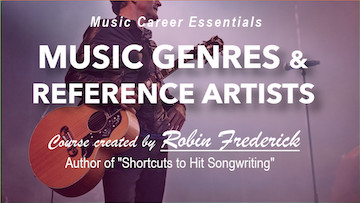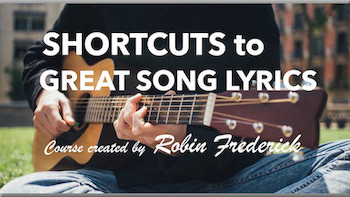If you could ask a question of any successful hit songwriter, what would you want to know? You’d probably ask how they do it. In fact, you can ask that question and get an answer… just by taking an in-depth look at their hits.
WHY THIS SONG?
Brandi Carlile is not only a Grammy Award winning songwriter and performer, she has also written and performed songs featured in a wide range of motion pictures—from Barbie: the Movie to Sisterhood of the Traveling Pants—and hit television shows like Grey’s Anatomy and Ted Lasso. (Visit Tunefind.com for a long list.) “Carried Me With You” was written for the Pixar film Onward and was nominated for a Grammy for Best Song Written for Visual Media.
“Carried Me With You” – Brandi Carlile
Songwriters: Brandi Carlile, Phil Hanseroth, Tim Hanseroth
TECHNIQUES TO HEAR AND TRY
• Use melody to create a solid song structure.
• Try lyric examples to express your core idea.
• Maintain your personal style when writing for Film & TV.
LISTEN TO THE SONG. READ THE LYRICS.
Watch the lyric video on YouTube.
Read the lyric here.
GENRE/STYLE (Americana / Indie Folk)
(What is a genre? Watch this video.)
This blockbuster, international Pop hit is currently topping Billboard’s Hot 100 music chart and headed for a billion listens on Spotify. It has become the number one Pop song in almost all European and Asian countries, as well as the U.S. and U.K.
While many current U.S. Pop hits are more rhythmically complex than this song, the very hummable melody, tightly focused lyric, and straight-forward Dance groove have given it enormous global appeal.
SONG STRUCTURE
“Carried Me With You” has a strong, well-developed structure following an 8-second intro.
VERSE 1 / PRE-CHORUS 1 / CHORUS
VERSE 2 / PRE-CHORUS 2 / CHORUS
BRIDGE (2:13)
PRE-CHORUS 1 / CHORUS
FIRST LINES
- Verse 1: “You’re the soul who understands…”
- Verse 2: “From the day it all began…”
- Pre-Chorus 1: “If you bear a heavy load…”
- Pre-Chorus 2: “And when my head was in the clouds…”
- Chorus: “Yeah, you carried me with you…”
- Bridge: “Oh, we’ll be sittin’ on the world together…”
TIP: We often go straight to the final chorus after a bridge. But here the song returns to the first pre-chorus as the track drops down to a a simple vocal with harmony and a few sparse piano notes. This allows the track to launch the final chorus with plenty of energy as the full band kicks in. If you’ve got a pre-chorus in your song, consider bringing it back after the bridge to provide a build-up to your final chorus.
LYRICS
USE YOUR OPENING LINES TO SET THE TONE
“Carried Me With You” is an uplifting song with a positive lyric that feels honest, fresh, and authentic. This is a real challenge to pull off. Lyrics like this often fall into a kind of forced goodwill and trite phrases that don’t ring true. But right from the opening lines, this singer sounds serious and believable.
You’re the soul who understands
The scars that made me who I am
By using words with strong emotional associations (soul, scars), listeners can get involved in the song right away. These lines convey a clear idea of how deep the commitment is between the singer and “you” and describe a situation many listeners can relate to; they may have experienced it themselves or want a relationship like that.
Find out more about words that come with extra associations and how to use them.
TRY IT NOW
The opening lines of a song are crucial to getting listeners involved. Take a look at the opening lines in a few of your songs to see if they engage the listener and get them interested enough to stick around. If not, try adding words with more emotional associations or drop the listener into the middle of the situation.
USE EXAMPLES TO COMMUNICATE YOUR CORE IDEA
Songs of friendship, love, and mutual support are always popular with listeners and great for movie and television uses. (There are plenty of scenes with themes like this.) Here the core idea—We can trust and rely on each other—is clear right from the start and remains in focus throughout the entire song.
Take a look at this lyric and notice how the songwriters create pairs of lines that demonstrate what it means to be in a supportive relationship.
If you bear a heavy load
I’ll be your wheels, I’ll be the road
And when I hurt a bit too deep
You watched me as I fell asleep
And when my head was in the clouds
You found a way to pull me out
TRY IT NOW
Examples that show what you mean will always capture listeners more effectively than simply stating the obvious. A blend of both—direct statement and examples—is a great way to go in a lyric in any genre. Listen to a few of your favorite songs to see how they use examples.
MELODY
Melody is the simplest and most effective way to create song structure. How do listeners know when they’re hearing a verse, a chorus, or a bridge? What is the secret to keeping your lyric from sounding like one long string of words? Can you launch a chorus with a rush of energy? The answer: By adding CONTRAST to your melody.
Let’s take a look at the melody of “Carried Me With You” then try some of these ideas in songs of your own.
VERSE MELODY: The melody pattern in the verse is simple and very common. Line 1 and Line 3 are close to the same. Line 2 and Line 4 are the same. The melody stays in a conversational range with a mix of down and up motion.
PRE-CHORUS MELODY: Line 1 and 2 have essentially the same descending melody line, although Line 2 is lower than Line 1. This line isn’t similar to anything in the verse melody at all, making it clear that we’re in a new section. Contrast in melody direction and pattern is a good way to create a well-defined structure.
CHORUS MELODY: The chorus melody starts with a leap upward of an octave from the last note of the pre-chorus to the first note of the chorus. That’s a big jump and it definitely grabs the listener’s attention, so putting a lyric with the title in that line is a great idea. The rest of the chorus melody has more leaps and up-down motion than either the verse or pre-chorus.
BRIDGE MELODY: Here the melody rocks back and forth between two notes. If you have a chorus with a lot of melody motion in it, as this one does, then a simple, static bridge melody is a good way to go. Again, contrast.
TRY IT NOW
Go through one of your own songs to check if each section has its own melodic identity. How is your verse melody different from your chorus melody? Is there enough contrast? Could listeners hear the diffference?
CHORDS
The chords for this song are relatively easy to play and can be simplified. The progression is not as repetitive as today’s Pop songs. Instead, it’s closer to the Indie Follk genre which uses chord progressions to support the changing melody in individual song sections.
Here are the chord progression and lyrics for “Carried Me With You.”
CAN YOU MAINTAIN YOUR PERSONAL STYLE WHILE WRITING FILM & TV SONGS?
Brandi Carlile is an artist whose signature voice and songwriting style are very recognizable. Even when she’s co-writing a song for a specific use in a film, as she did with this song, she still gives it her personal stamp. If she were to write a song to be used in a commercial for breakfast cereal, you can bet it would still sound like Brandi Carlile!
As a singer-songwriter, your voice is the most obvious way to give your songs your personal stamp. Turn it into a plus by focusing your songwriting on those genres where you excel. Record songs that showcase your strengths and character. Consider using a palette of sounds, like a painter uses a characteristic range of hues. (Think of the Impressionists.) If you’re an acoustic artist, stick with that, if you lean more toward Electro-Pop sounds, stay there. Experimentation is good, but define your core sonic identity first, then branch out.
TRY A COVER SONG
By the way, you don’t have to limit yourself to original songs; try a few cover songs in your own style. This is a great way to explore your brand and sound. Brandi Carlile has had at least three cover songs featured in major motion pictures: “Closer to Fine” (from Barbie: The Movie) originally recorded by the Indigo Girls; “I Put a Spell On You” (from The Social Network), an American Standard recorded by dozens of great artists; and “The Chain” (as The Highwomen from the movie The Kitchen), originally recorded by Fleetwood Mac.
Pick a well-known hit song and re-imagine it in your own style. How would you change that song? What is your style? What makes you unique?



